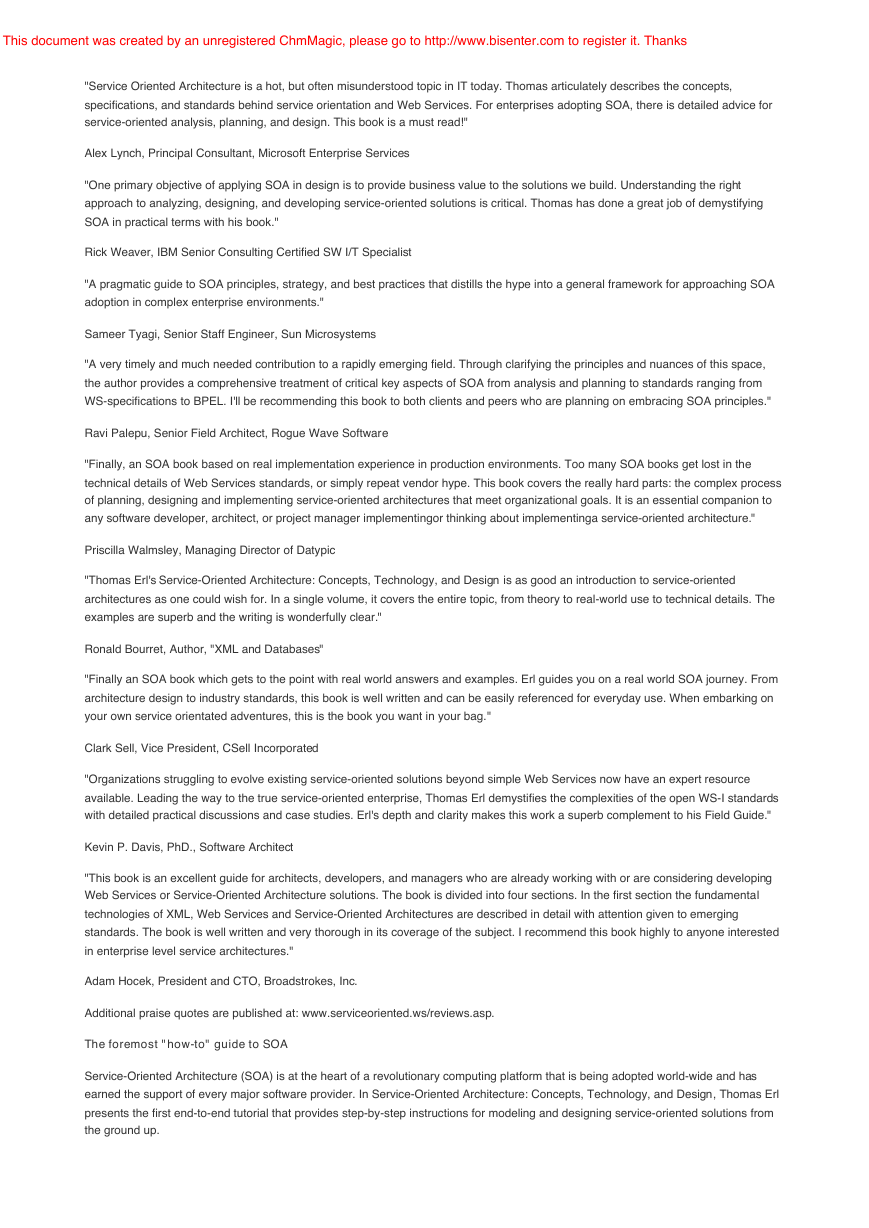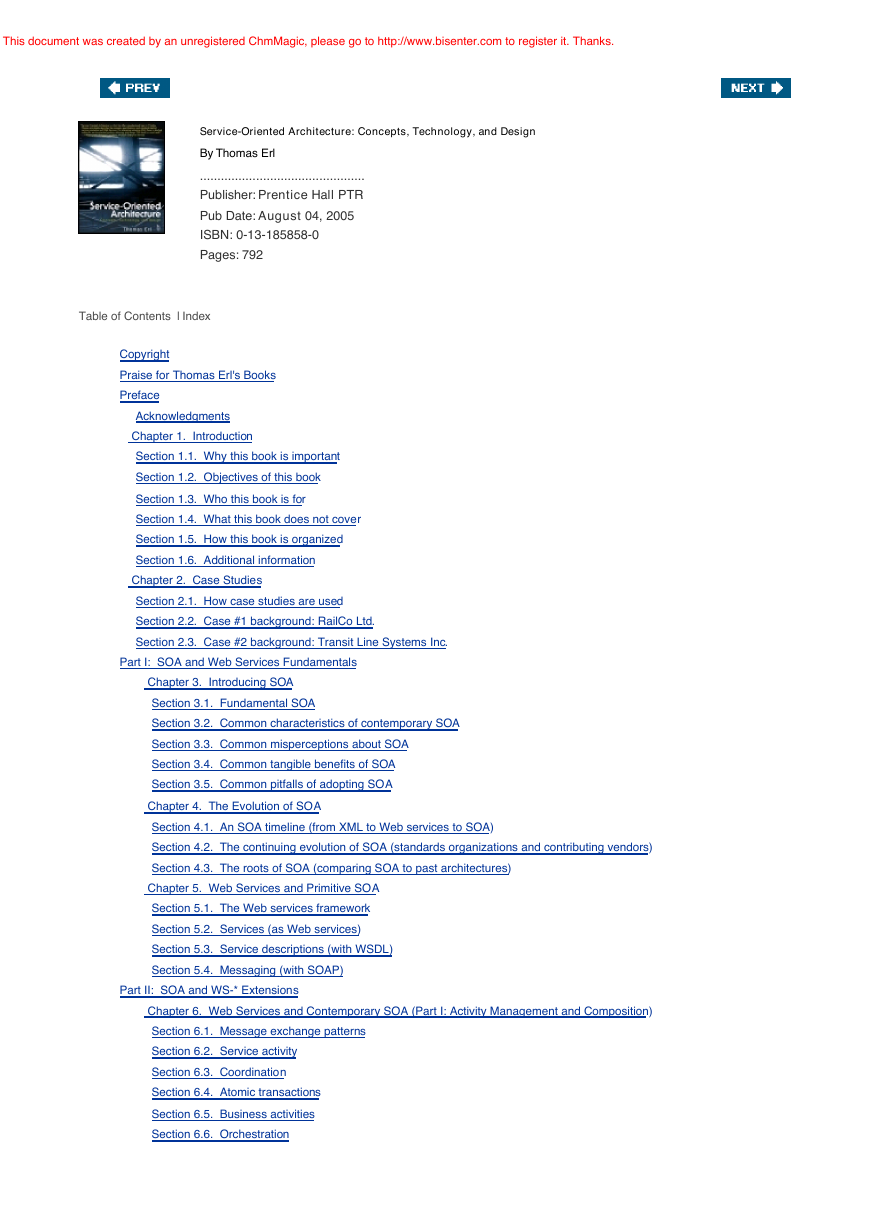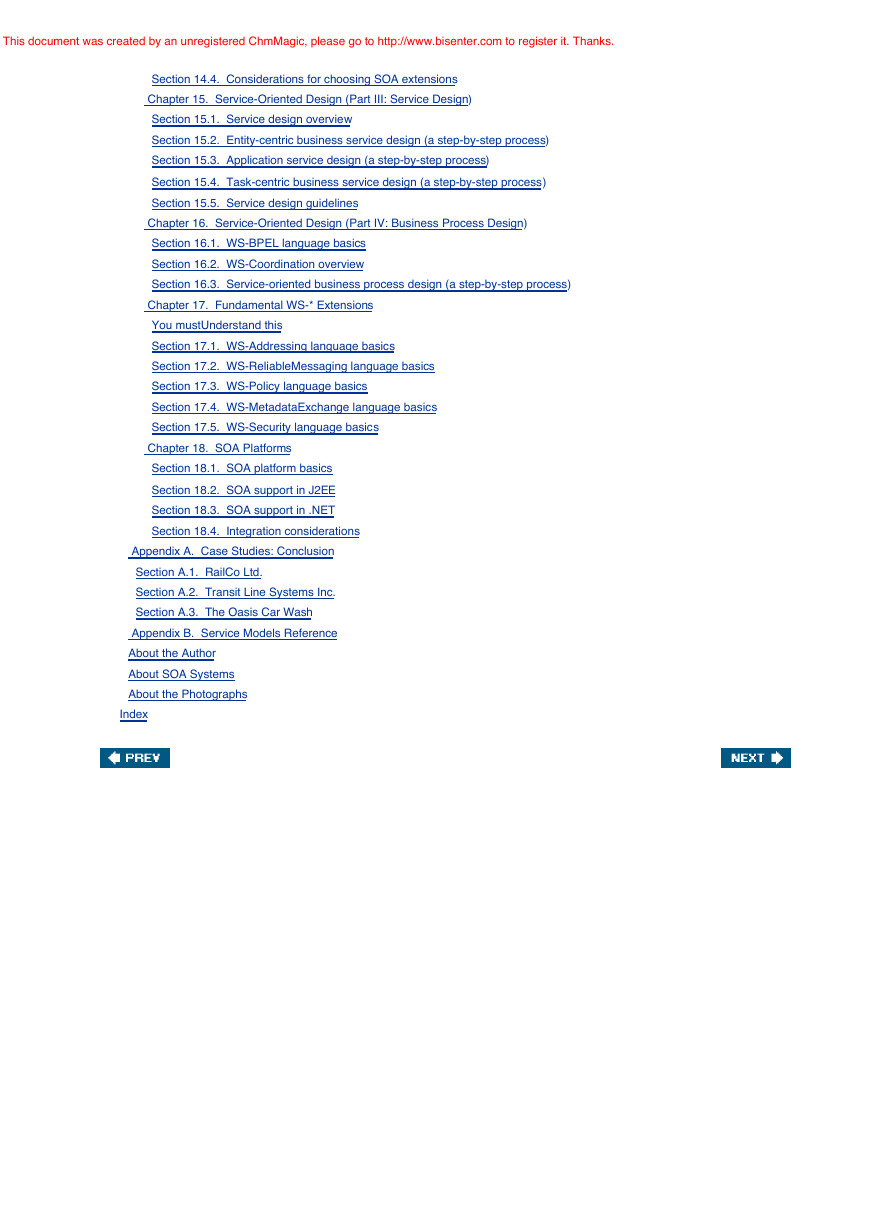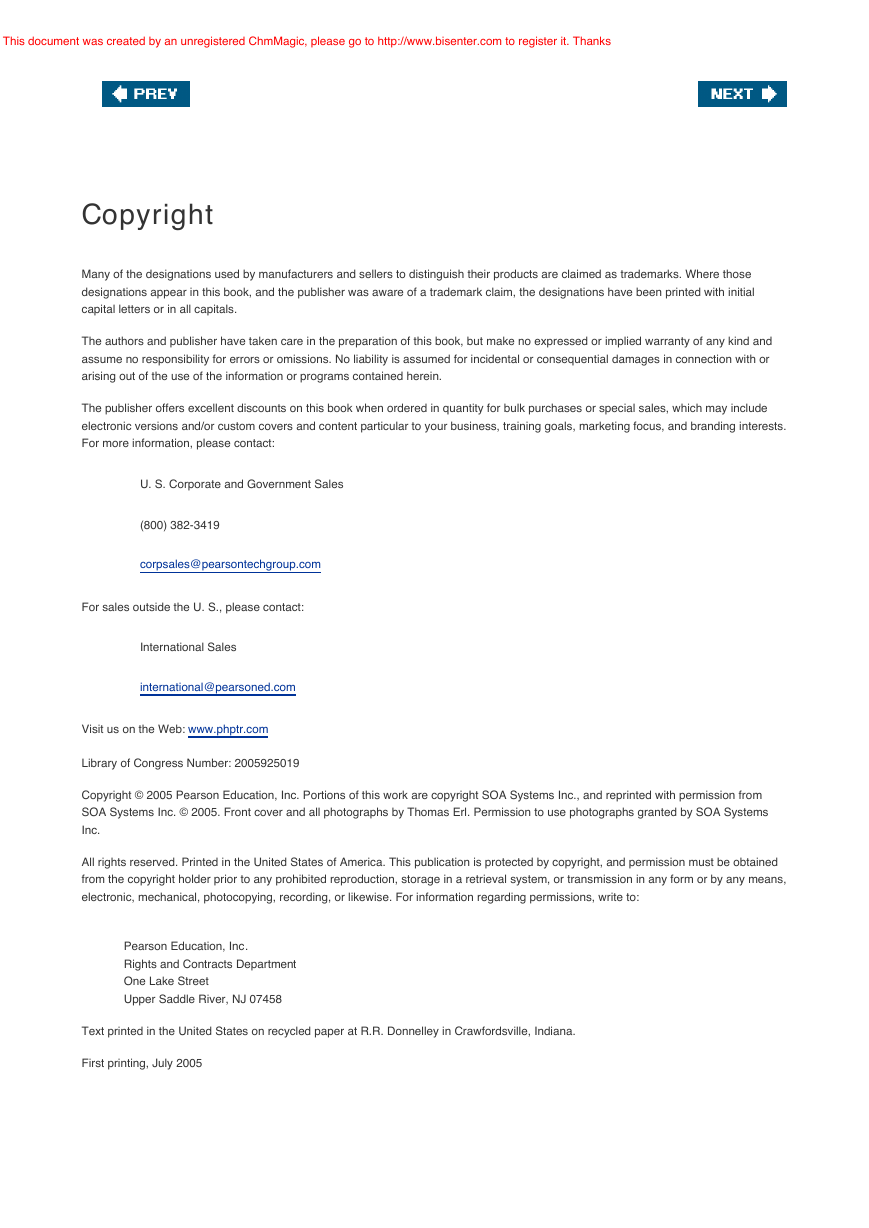Service-Oriented Architecture: Concepts, Technology, and Design
Table of Contents
Copyright
Praise for Thomas Erl's Books
Preface
Acknowledgments
Chapter 1. Introduction
Section 1.1. Why this book is important
Section 1.2. Objectives of this book
Section 1.3. Who this book is for
Section 1.4. What this book does not cover
Section 1.5. How this book is organized
Section 1.6. Additional information
Chapter 2. Case Studies
Section 2.1. How case studies are used
Section 2.2. Case #1 background: RailCo Ltd.
Section 2.3. Case #2 background: Transit Line Systems Inc.
Part I: SOA and Web Services Fundamentals
Chapter 3. Introducing SOA
Section 3.1. Fundamental SOA
Section 3.2. Common characteristics of contemporary SOA
Section 3.3. Common misperceptions about SOA
Section 3.4. Common tangible benefits of SOA
Section 3.5. Common pitfalls of adopting SOA
Chapter 4. The Evolution of SOA
Section 4.1. An SOA timeline (from XML to Web services to SOA)
Section 4.2. The continuing evolution of SOA (standards organizations and contributing vendors)
Section 4.3. The roots of SOA (comparing SOA to past architectures)
Chapter 5. Web Services and Primitive SOA
Section 5.1. The Web services framework
Section 5.2. Services (as Web services)
Section 5.3. Service descriptions (with WSDL)
Section 5.4. Messaging (with SOAP)
Part II: SOA and WS-* Extensions
Chapter 6. Web Services and Contemporary SOA (Part I: Activity Management and Composition)
Section 6.1. Message exchange patterns
Section 6.2. Service activity
Section 6.3. Coordination
Section 6.4. Atomic transactions
Section 6.5. Business activities
Section 6.6. Orchestration
Section 6.7. Choreography
Chapter 7. Web Services and Contemporary SOA (Part II: Advanced Messaging, Metadata, and Security)
Section 7.1. Addressing
Section 7.2. Reliable messaging
Section 7.3. Correlation
Section 7.4. Policies
Section 7.5. Metadata exchange
Section 7.6. Security
Section 7.7. Notification and eventing
Part III: SOA and Service-Orientation
Chapter 8. Principles of Service-Orientation
Section 8.1. Service-orientation and the enterprise
Section 8.2. Anatomy of a service-oriented architecture
Section 8.3. Common principles of service-orientation
Section 8.4. How service-orientation principles inter-relate
Section 8.5. Service-orientation and object-orientation (Part II)
Section 8.6. Native Web service support for service-orientation principles
Chapter 9. Service Layers
Section 9.1. Service-orientation and contemporary SOA
Section 9.2. Service layer abstraction
Section 9.3. Application service layer
Section 9.4. Business service layer
Section 9.5. Orchestration service layer
Section 9.6. Agnostic services
Section 9.7. Service layer configuration scenarios
Part IV: Building SOA (Planning and Analysis)
Chapter 10. SOA Delivery Strategies
Section 10.1. SOA delivery lifecycle phases
Section 10.2. The top-down strategy
Section 10.3. The bottom-up strategy
Section 10.4. The agile strategy
Chapter 11. Service-Oriented Analysis (Part I: Introduction)
"Service-oriented architecture" vs. "Service-oriented environment"
Section 11.1. Introduction to service-oriented analysis
Section 11.2. Benefits of a business-centric SOA
Section 11.3. Deriving business services
Chapter 12. Service-Oriented Analysis (Part II: Service Modeling)
Section 12.1. Service modeling (a step-by-step process)
Section 12.2. Service modeling guidelines
Section 12.3. Classifying service model logic
Section 12.4. Contrasting service modeling approaches (an example)
Part V: Building SOA (Technology and Design)
Chapter 13. Service-Oriented Design (Part I: Introduction)
Section 13.1. Introduction to service-oriented design
Section 13.2. WSDL-related XML Schema language basics
Section 13.3. WSDL language basics
Section 13.4. SOAP language basics
Section 13.5. Service interface design tools
Chapter 14. Service-Oriented Design (Part II: SOA Composition Guidelines)
Section 14.1. Steps to composing SOA
Section 14.2. Considerations for choosing service layers
Section 14.3. Considerations for positioning core SOA standards
Section 14.4. Considerations for choosing SOA extensions
Chapter 15. Service-Oriented Design (Part III: Service Design)
Section 15.1. Service design overview
Section 15.2. Entity-centric business service design (a step-by-step process)
Section 15.3. Application service design (a step-by-step process)
Section 15.4. Task-centric business service design (a step-by-step process)
Section 15.5. Service design guidelines
Chapter 16. Service-Oriented Design (Part IV: Business Process Design)
Section 16.1. WS-BPEL language basics
Section 16.2. WS-Coordination overview
Section 16.3. Service-oriented business process design (a step-by-step process)
Chapter 17. Fundamental WS-* Extensions
You mustUnderstand this
Section 17.1. WS-Addressing language basics
Section 17.2. WS-ReliableMessaging language basics
Section 17.3. WS-Policy language basics
Section 17.4. WS-MetadataExchange language basics
Section 17.5. WS-Security language basics
Chapter 18. SOA Platforms
Section 18.1. SOA platform basics
Section 18.2. SOA support in J2EE
Section 18.3. SOA support in .NET
Section 18.4. Integration considerations
Appendix A. Case Studies: Conclusion
Section A.1. RailCo Ltd.
Section A.2. Transit Line Systems Inc.
Section A.3. The Oasis Car Wash
Appendix B. Service Models Reference
About the Author
About SOA Systems
About the Photographs
Index
SYMBOL
A
B
C
D
E
F
G
H
I
J
K
L
M
N
O
P
Q
R
S
T
U
V
W
X
















 2023年江西萍乡中考道德与法治真题及答案.doc
2023年江西萍乡中考道德与法治真题及答案.doc 2012年重庆南川中考生物真题及答案.doc
2012年重庆南川中考生物真题及答案.doc 2013年江西师范大学地理学综合及文艺理论基础考研真题.doc
2013年江西师范大学地理学综合及文艺理论基础考研真题.doc 2020年四川甘孜小升初语文真题及答案I卷.doc
2020年四川甘孜小升初语文真题及答案I卷.doc 2020年注册岩土工程师专业基础考试真题及答案.doc
2020年注册岩土工程师专业基础考试真题及答案.doc 2023-2024学年福建省厦门市九年级上学期数学月考试题及答案.doc
2023-2024学年福建省厦门市九年级上学期数学月考试题及答案.doc 2021-2022学年辽宁省沈阳市大东区九年级上学期语文期末试题及答案.doc
2021-2022学年辽宁省沈阳市大东区九年级上学期语文期末试题及答案.doc 2022-2023学年北京东城区初三第一学期物理期末试卷及答案.doc
2022-2023学年北京东城区初三第一学期物理期末试卷及答案.doc 2018上半年江西教师资格初中地理学科知识与教学能力真题及答案.doc
2018上半年江西教师资格初中地理学科知识与教学能力真题及答案.doc 2012年河北国家公务员申论考试真题及答案-省级.doc
2012年河北国家公务员申论考试真题及答案-省级.doc 2020-2021学年江苏省扬州市江都区邵樊片九年级上学期数学第一次质量检测试题及答案.doc
2020-2021学年江苏省扬州市江都区邵樊片九年级上学期数学第一次质量检测试题及答案.doc 2022下半年黑龙江教师资格证中学综合素质真题及答案.doc
2022下半年黑龙江教师资格证中学综合素质真题及答案.doc